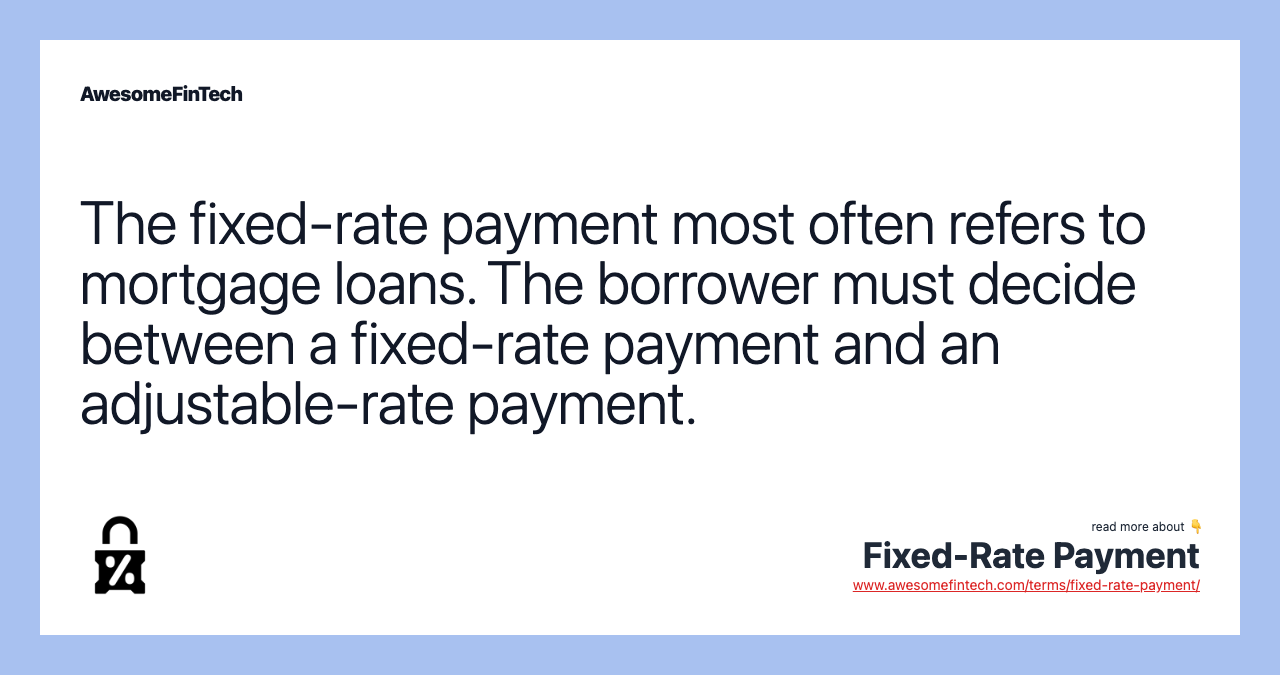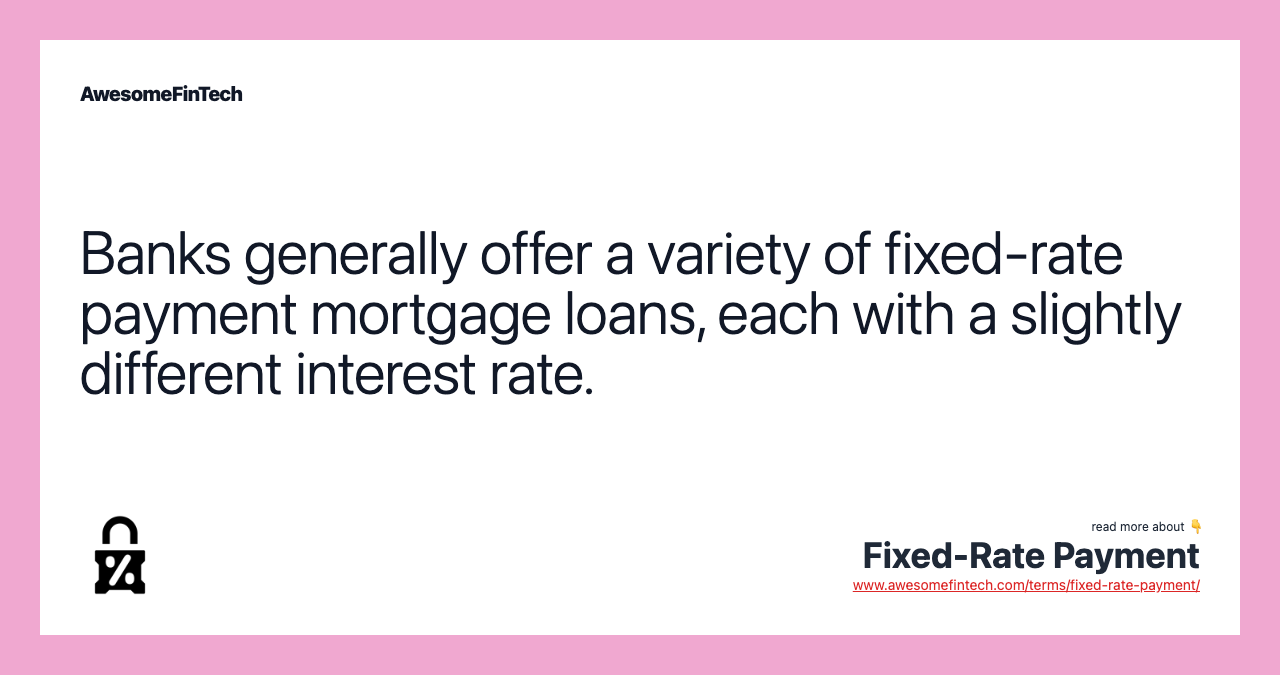Fixed-Rate Payment
Table of Contents Expand The difference between the average interest rate for a 30-year fixed-rate mortgage and the average rate for a 30-year adjustable-rate mortgage The amount paid for a fixed-rate payment loan remains the same month after month, but the proportions that go to pay off principal and interest change every month. When interest rates were high, a bank was more inclined to offer the introductory rate break on fixed-rate loans, because it anticipated that rates on new loans will go lower. A bank will generally offer a variety of fixed-rate payment mortgage loans, each with a slightly different interest rate. Banks generally offer a variety of fixed-rate payment mortgage loans, each with a slightly different interest rate.

What Is a Fixed-Rate Payment?
A fixed-rate payment is an installment loan with an interest rate that cannot be changed during the life of the loan. The payment amount also will remain the same, though the proportions that go toward paying off the interest and paying off the principal will vary. A fixed-rate payment is sometimes referred to as a “vanilla wafer” payment, presumably because it is very predictable and contains no surprises.



How a Fixed-Rate Payment Works
A fixed-rate payment agreement is most often used in mortgage loans. Homebuyers generally have a choice of fixed-rate mortgage loans or adjustable-rate (ARM) mortgage loans. Adjustable-rate mortgage loans are also known as floating rate loans. Homebuyers typically can decide which loan type is the better choice for them.
A bank will generally offer a variety of fixed-rate payment mortgage loans, each with a slightly different interest rate. Typically, a homebuyer can choose a 15-year term or a 30-year term. Slightly lower rates are offered for veterans and for Federal Housing Authority (FHA) loans. Although loans for veterans and those available through the FHA have lower interest rates, borrowers are typically required to purchase additional mortgage insurance to protect against default.
Banks also offer options for adjustable-rate loans. Historically, these could have a substantially lower starting interest rate than fixed-rate payment loans. In times when interest rates were low, the homebuyer could usually get an even lower introductory rate on an adjustable-rate mortgage, offering a break on the payments in the months immediately after the purchase. When the introductory period ended, the bank raised the rate and the payment amounts as interest rates were rising. When interest rates were high, a bank was more inclined to offer the introductory rate break on fixed-rate loans, because it anticipated that rates on new loans will go lower.
However, with mortgage rates hovering below 5% since the 2008 housing crisis, the gap between fixed-rate and variable-rate loans has practically closed. As of Aug. 13, 2020, the average interest rate nationwide on a 30-year fixed mortgage was 2.96%. The rate for a comparable adjustable-rate loan was 2.9%. The latter is a so-called “5/1 ARM,” meaning the rate remains fixed for at least five years. After five years, it may be adjusted upward annually.
The difference between the average interest rate for a 30-year fixed-rate mortgage and the average rate for a 30-year adjustable-rate mortgage
Special Considerations
The amount paid for a fixed-rate payment loan remains the same month after month, but the proportions that go to pay off principal and interest change every month. The earliest payments are made up of more interest than principal. Month by month, the amount of interest paid declines gradually while the principal paid increases. This is called loan amortization.
Example of a Fixed-Rate Payment Loan
The term is used in the home loan industry to refer to payments under a fixed-rate mortgage which are indexed on a common amortization chart. For example, the first few lines of an amortization schedule for a $250,000, 30-year fixed-rate mortgage with a 4.5% interest rate look like the table below.
Example of a Loan Amortization Schedule
Dollar Amounts
Month One
Month Two
Month Three
Total Payment
Total Interest
Loan Balance
$249,670.79
$249,340.34
$249,008.65
Note that the interest payment goes down from month to month, albeit slowly, while the principal payment increases slightly. The overall loan balance goes down. However, the monthly payment of $1,266.71 remains the same.
Related terms:
Amortization : Formula & Calculation
Amortization is an accounting technique used to periodically lower the book value of a loan or intangible asset over a set period of time. read more
Amortization Schedule
An amortization schedule is a complete schedule of periodic blended loan payments, showing the amount of principal and the amount of interest. read more
Adjustable-Rate Mortgage (ARM)
An adjustable-rate mortgage is a type of mortgage in which the interest rate paid on the outstanding balance varies according to a specific benchmark. read more
Fixed-Rate Mortgage
A fixed-rate mortgage is an installment loan that has a fixed interest rate for the entire term of the loan. read more
Fixed Interest Rate
A fixed interest rate remains the same for a loan's entire term, making long-term budgeting easier. Some loans combine fixed and variable rates. read more
Floating Interest Rate
A floating interest rate is an interest rate that moves up and down with the rest of the market or along with an index. read more
Initial Interest Rate Cap
The initial interest rate cap is defined as the maximum amount the interest rate on an adjustable-rate loan can adjust on its first scheduled adjustment date. read more
Installment Debt
Installment debt is a loan repaid by the borrower in regular payments. Read about different types of installment debt, along with their pros and cons. read more